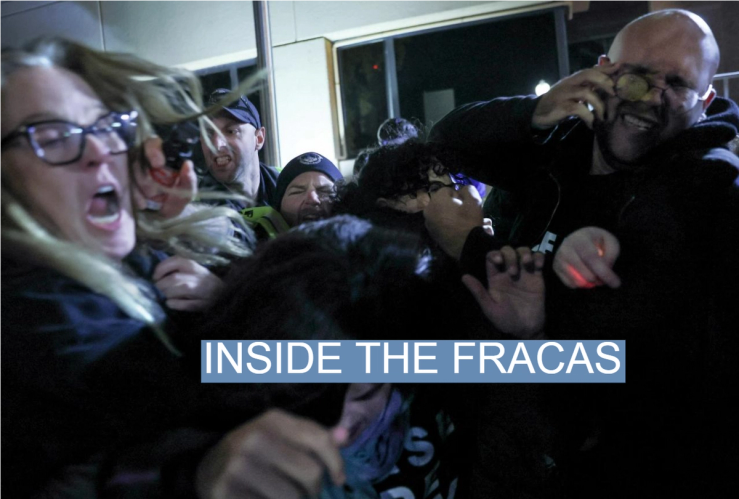The Scene
On Wednesday night, more than 150 protesters demanding a ceasefire in Gaza blocked entrances to the Democratic National Committee’s offices near the Capitol, singing, chanting, and holding electric vigil candles until police officers forcibly removed them.
By Thursday morning, the protesters — organized by IfNotNow and Jewish Voice for Peace, which have staged multiple acts of civil disobedience since the war began last month — were fending off accusations of violence and terror.
Two Democratic members of Congress falsely accused protesters of trying to storm the building; others invoked the Capitol riot on Jan. 6, 2021. After U.S. Capitol Police released a statement on the protest, announcing the arrest of a New York man who they said had attacked two officers and claiming other officers had been pepper sprayed, DNC Chairman Jaime Harrison praised their response.
“As Americans we have a right to demonstrate peacefully, but violence is never acceptable,” said Harrison. President Biden and First Lady Jill Biden called into a party meeting on Thursday, thanking the police for dispersing protesters.
Activists who’d led the protest pushed back on Thursday. The plan, they explained, was for protesters to block the DNC’s entrances while members of Congress and congressional candidates were inside, then confront them as they left. One group of demonstrators projected lights on the building, spelling out “Voters Say: Ceasefire Now.”
But the protest also came as members were on edge over antisemitic threats against them and their constituents that have escalated since the Hamas attack and Israel’s response, as well as some left-wing events and materials that featured defenses of the 10/7 massacre.
“Forcing police to guess intent is irresponsible and dangerous,” Rep. Sean Casten, D-Ill., warned protestors on X.
Those fears and resentments came to a head as some Democrats, in no mood to carefully parse the nuances of which group shouting outside their door had backed which position, immediately complained of extremist intimidation.
California Rep. Brad Sherman, who on Wednesday called the protesters “pro-Hamas demonstrators,” initially claimed that they had been “attempting to break in.” He did not repeat that allegation in a subsequent CNN appearance, but multiple media outlets ran with the claim that police kept protesters from entering the DNC.
“I would ask anyone who makes these claims to produce evidence,” said IfNotNow’s Eva Borgwardt, “because the only people that I saw use violence yesterday at that protest were the police.”
In this article:
David’s view
The demonstrations, which came from two established left-wing Jewish groups that have long protested Israeli policy, did not appear nearly as dangerous as many of the statements indicated. But the groups involved ramped up their tactics at an especially volatile time for both Democrats and Republicans that put them in a political buzzsaw.
The left-wing coalition of groups now demanding a Gaza ceasefire pre-dates the war; the self-described “anti-Zionist” Jewish Voice for Peace and IfNotNow, participants in the Wednesday night protests, were founded in 1996 and 2014, respectively. They made some inroads in the Democratic Party, especially among its youngest voters, as Netanyahu-era governments fought with President Barack Obama over Iran and West Bank settlements and as Israeli leaders embraced President Donald Trump. Meanwhile, memories of past Israeli peace efforts began fading away.
Since Oct. 7, however, even as antiwar activists have been ostracized by much of their party, public opinion has shifted their way. In a Quinnipiac poll released Thursday, Democrats said they were more sympathetic to the Palestianians than the Israelis by a 7-point margin; a Reuters/Ipsos poll this week found a majority of Americans support a ceasefire.
But the vast majority of congressional Democrats have backed the Biden administration’s position — support for the Israeli military operation, with a “humanitarian pause” for aid and hostage releases, rather than demanding a stop to the bombing and talks on a full ceasefire. A Monday press conference with House Democrats who supported a ceasefire, joined by a progressive rabbis organization, got little attention. A protest on the DNC’s doorstop promised to get more.
I covered the protest on Wednesday, arriving at 7:20 p.m., after organizers had alerted media outlets that a nearby vigil would end with a protest at the DNC. For around 10 minutes, protesters marching from the vigil were stopped by police on bicycles. When allowed to move forward, dozens of protesters moved past the police and rushed to the entrances of the DNC, standing in front of them and resisting officers who pulled them away.
By 7:42 p.m, the main entrance had been cleared, with a line of officers blocking anyone else from walking up, and members being escorted out in vehicles that breezed past the protest. Organizers, who’d been part of other direct actions broken up by police, were surprised at how quickly they acted, without the warnings to disperse that they’d grown used to.
“We went last night, arm in arm, to sign, to light candles in memory of the dead, and to attempt to engage, actually, with Democratic leadership,” said Dani Noble, an organizer with Jewish Voice for Peace.
The protest was illegal — there was no permit, and they were stopping people from exiting the building. National Lawyers Guild representatives moved around the crowd, telling protesters where to move if they did not want to be arrested.
But coverage of the protest, and some Democratic reactions, portrayed a more violent, chaotic scene than the one broken up quickly by police. House office buildings, a block and a half away, were locked down as the protest was dispersed.
Democrats inside the DNC, apart from Sherman and Massachusetts Rep. Jake Auchincloss, did not repeat claims that protestors had attempted to break inside. But they largely agreed with the police statement on what happened, blaming the protesters for violence as they resisted the effort to remove them and scuffled with officers.
“The right to demonstrate and peaceably assemble is a constitutionally protected one,” Michigan Rep. Hillary Scholten said in a statement. “But demonstrations such as this one — in which police orders to leave private property were ignored, Members of Congress were blocked from exiting, and six police officers were injured — cannot be classified as peaceful.”
Both parties joined in condemning the movement’s tactics. Republicans, some of whom had characterized a sit-in last month at a House office building as an “insurrection,” took the same how-dare-they tack this week. Speaker Mike Johnson labeled the crowd, which included progressive rabbis, antisemitic and “pro-Hamas.” Democrats, who have largely rejected the campaign for a ceasefire, characterized this direct action as a dangerous mistake.
Most media coverage portrayed the protest as a “clash” (Fox News) that “turned violent” (CNN). A peaceful protest in downtown D.C. two weeks earlier got a fraction of the attention. Some Democrats, like Sherman, also said that it was unfair to see this action take attention from Tuesday’s peaceful March for Israel, which attracted far more participants on the other side of the political debate and didn’t feature any civil disobedience.
Pro-ceasefire protesters, by now, are used to accusations of antisemitism, even if they’re Jewish, and of support for Hamas, even if they denounce it. They learned something else this week — that the direct action tactics they’d used for years could unite Democrats against them this time, lumping them in with insurrectionists. And it happened as polling was moving their way.
Notable
- In Axios, Andrew Solender talks with more Democrats about the protests and their fears, including an anonymous member who says it “scared me more than January 6.”
- In the Washington Post, Ellie Silverman and Peter Hermann speak with more protesters, agonizing over how the night was handled and covered; one participant “thought defying these initial police orders would lead to something she had experienced at other protests in Philadelphia,” a few warnings followed by willing arrests.


